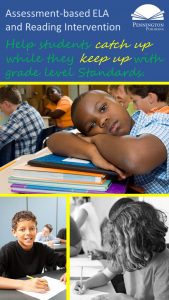Effective Secondary School Reading Staff Development
“Oh no… another obligatory reading staff development. If the presenter says ‘every teacher a teacher of reading’ just one time, I will walk out.”
“What does this have to do with me? I teach math. Another district-mandated reading-across-the-curriculum in-service. Ho-hum. Glad I brought papers to grade.”
As an administrator, literacy coach, English-language Arts teacher, or staff developer, you know the challenge. How can you train and convince such a diverse group of colleagues, representing the full slate of academic disciplines, that staff development in reading is valuable at the middle or high school level?
As educators have addressed the issues and suggested instructional strategies to respond to the growing “achievement gap,” many have come to the point of validating reading guru Anita Archer’s comment that “the ‘achievement gap’ is chiefly a ‘literacy gap.’” Today, there is wide consensus that secondary schools need to improve delivery of reading instruction, even at the expense of content-laden curricula.
“Oh great. Another thing to cram into my course. I don’t have the time to teach everything I am supposed to teach-not to mention what I want to teach.”
As a reading specialist/staff developer, once assigned to a high school, I know how secondary teachers, and even elementary teachers (been there-done that, too) can be a tough audience during a reading-based staff development. However, I’ve found that even the most obstinate, stuck-in-the-mud teachers do care about their students. Most will care enough to be willing to try something new, if they see the direct pay-off for their students.
In my experience, to get staff buy-in, you’ve got to accomplish three fundamental goals:
1. Ensure that all teachers feel that the strategies directly apply, in some degree, to their own academic disciplines. And let’s be honest, the matter is less relevant to some.
2. Give teachers something they can use the next day, and
3. Get the staff actively involved in the presentation.
Here are three sure-fire reading staff developments that I have presented at secondary schools and a nice resource for each:
1. Train and convince every teacher to assign reading in their academic discipline for homework on a regular basis. Here’s how.
2. Train and convince every teacher to use the same language of instruction i.e., the same terminology, for teaching and practicing reading strategies. The SCRIP Comprehension Cues is a set of self-questioning prompts that students can use to promote the author-reader dialog. Beyond the memorable mnemonic, the advantage to these strategies is that they work equally well with expository and narrative text (all academic disciplines).
3. Train and convince every teacher to teach and have students use the same read-study method for expository reading. The PQ RAR method is a nice update on the “tried and true” SQ3R read-study method.
Using the same language of instruction is simply “user-friendly” for our students. Having similar instructional strategies lets students know that we do actually talk to teachers in other departments. More importantly, a staff that commits to using these strategies will significantly impact the reading performance of its students and help to bridge the “literacy gap.”
*****

The Science of Reading Intervention Program
The Science of Reading Intervention Program: Word Recognition includes explicit, scripted, sounds to print instruction and practice with the 5 Daily Google Slide Activities every grades 4-adult reading intervention student needs: 1. Phonemic Awareness and Morphology 2. Blending, Segmenting, and Spelling 3. Sounds and Spellings (including handwriting) 4. Heart Words Practice 5. Sam and Friends Phonics Books (decodables). Plus, digital and printable sound wall cards, speech articulation songs, sounds to print games, and morphology walls. Print versions are available for all activities. First Half of the Year Program (55 minutes-per-day, 18 weeks)
The Science of Reading Intervention Program: Language Comprehension resources are designed for students who have completed the word recognition program or have demonstrated basic mastery of the alphabetic code and can read with some degree of fluency. The program features the 5 Weekly Language Comprehension Activities: 1. Background Knowledge Mentor Texts 2. Academic Language, Greek and Latin Morphology, Figures of Speech, Connotations, Multiple Meaning Words 3. Syntax in Reading 4. Reading Comprehension Strategies 5. Literacy Knowledge (Narrative and Expository). Second Half of the Year Program (30 minutes-per-day, 18 weeks)
The Science of Reading Intervention Program: Assessment-based Instruction provides diagnostically-based “second chance” instructional resources. The program includes 13 comprehensive assessments and matching instructional resources to fill in the yet-to-be-mastered gaps in phonemic awareness, alphabetic awareness, phonics, fluency (with YouTube modeled readings), Heart Words and Phonics Games, spelling patterns, grammar, usage, and mechanics, syllabication and morphology, executive function shills. Second Half of the Year Program (25 minutes-per-day, 18 weeks)
The Science of Reading Intervention Program BUNDLE includes all 3 program components for the comprehensive, state-of-the-art (and science) grades 4-adult full-year program. Scripted, easy-to-teach, no prep, no need for time-consuming (albeit valuable) LETRS training or O-G certification… Learn as you teach and get results NOW for your students. Print to speech with plenty of speech to print instructional components.
Click the SCIENCE OF READING INTERVENTION PROGRAM RESOURCES for detailed program description, sample lessons, and video overviews. Click the links to get these ready-to-use resources, developed by a teacher (Mark Pennington, MA reading specialist) for teachers and their students.
Get the SCRIP Comprehension Cues FREE Resource:
![]()
Get the Diagnostic ELA and Reading Assessments FREE Resource:![]()
*****


